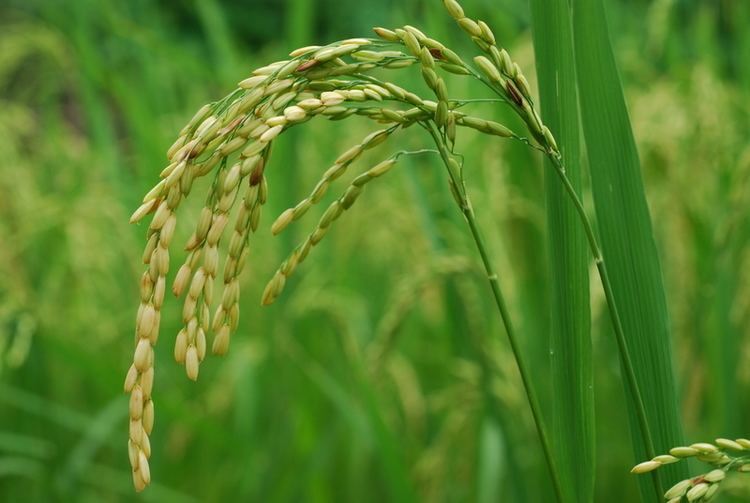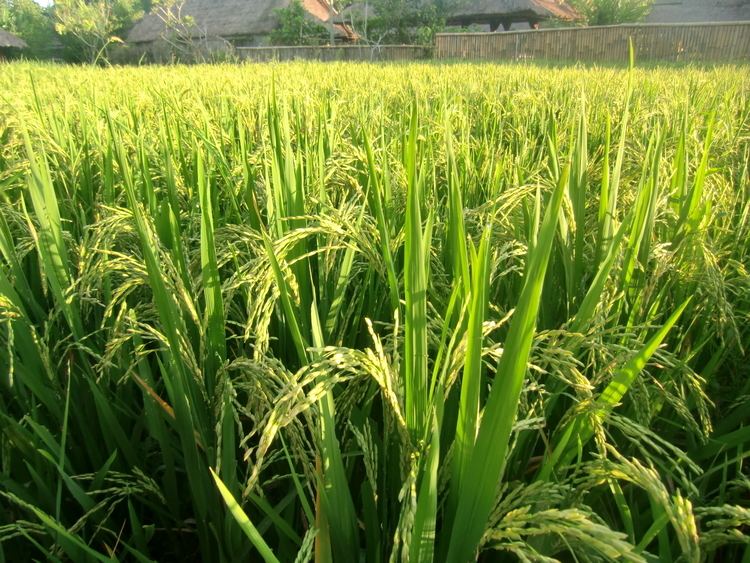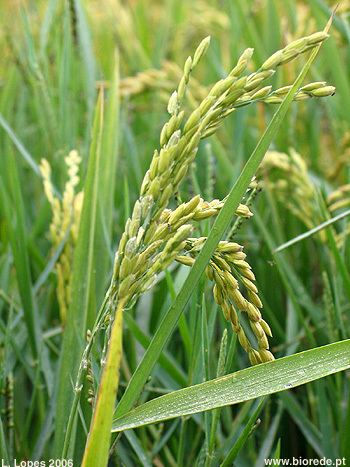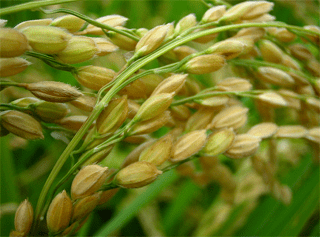Higher classification Oryza | Genus Oryza Rank Species | |
 | ||
Lower classifications Yamada Nishiki, Yumepirika, Oborozuki, Oryza sativa 'Chakhao, Oryza sativa 'Chakhao | ||
Oryza sativa the master plant
Oryza sativa, commonly known as Asian rice, is the plant species most commonly referred to in English as rice. Oryza sativa is a grass with a genome consisting of 430Mb across 12 chromosomes. It is renowned for being easy to genetically modify, and is a model organism for cereal biology.
Contents
- Oryza sativa the master plant
- Oryza sativa
- Classification
- Nomenclature and taxonomy
- Origins
- Continental East Asia
- South Asia
- Korean peninsula and Japanese archipelago
- Southeast Asia
- References

Oryza sativa
Classification

Oryza sativa contains two major subspecies: the sticky, short-grained japonica or sinica variety, and the nonsticky, long-grained indica variety. Japonica varieties are usually cultivated in dry fields, in temperate East Asia, upland areas of Southeast Asia, and high elevations in South Asia, while indica varieties are mainly lowland rices, grown mostly submerged, throughout tropical Asia. Rice occurs in a variety of colors, including: white, brown, black, purple, and red rices. Black rice (also known as purple rice) is a range of rice types, some of which are glutinous rice. Varieties include Indonesian black rice and Thai jasmine black rice.

A third subspecies, which is broad-grained and thrives under tropical conditions, was identified based on morphology and initially called javanica, but is now known as tropical japonica. Examples of this variety include the medium-grain 'Tinawon' and 'Unoy' cultivars, which are grown in the high-elevation rice terraces of the Cordillera Mountains of northern Luzon, Philippines.
Glaszmann (1987) used isozymes to sort O. sativa into six groups: japonica, aromatic, indica, aus, rayada, and ashina.

Garris et al. (2004) used simple sequence repeats to sort O. sativa into five groups: temperate japonica, tropical japonica and aromatic comprise the japonica varieties, while indica and aus comprise the indica varieties.
Nomenclature and taxonomy
Rice has been cultivated since ancient times and oryza is a classical Latin word for rice. Sativa means "cultivated".
Origins
Debates on the origins of the domesticated rice are numerous. In 2011, genetic evidence showed that all forms of Asian rice, both indica and japonica, sprang from a single domestication that occurred 8,200–13,500 years ago in China of the wild rice Oryza rufipogon. A 2012 study, through a map of rice genome variation, indicated that the domestication of rice occurred in the Pearl River valley region of China. From East Asia, rice was spread to South and Southeast Asia. Before this research, the commonly accepted view, based on archaeological evidence, is that rice was first domesticated in the region of the Yangtze River valley in China.
The precise date of the first domestication is unknown, but depending on the molecular clock estimate, the date is estimated to be 8,200 to 13,500 years ago. This is consistent with known archaeological data on the subject.
An older theory, based on one chloroplast and two nuclear gene regions, Londo et al. (2006) had proposed that O. sativa rice was domesticated at least twice—indica in eastern India, Myanmar, and Thailand; and japonica in southern China and Vietnam—though they concede that archaeological and genetic evidence exist for a single domestication of rice in the lowlands of China.
Because the functional allele for nonshattering, the critical indicator of domestication in grains, as well as five other single-nucleotide polymorphisms, is identical in both indica and japonica, Vaughan et al. (2008) determined a single domestication event for O. sativa happened in the region of the Yangtze River valley.
Continental East Asia
Rice appears to have been used by the early Neolithic populations of Lijiacun and Yunchanyan. Evidence of possible rice cultivation in China around 11,500 BP has been found, but whether the rice was indeed being cultivated, or instead was being gathered as wild rice is still questioned.
Zhao (1998) argues that collection of wild rice in the Late Pleistocene had, by 6400 BC, led to the use of primarily domesticated rice. Morphological studies of rice phytoliths from the Diaotonghuan archaeological site clearly show the transition from the collection of wild rice to the cultivation of domesticated rice. The large number of wild rice phytoliths at the Diaotonghuan level dating from 12,000–11,000 BP indicates that wild rice collection was part of the local means of subsistence. Changes in the morphology of Diaotonghuan phytoliths dating from 10,000–8,000 BP show that rice had by this time been domesticated. Analysis of Chinese rice residues from Pengtoushan, which were carbon 14 dated to 8200–7800 BC, show that rice had been domesticated by this time.
In 1998, Crawford and Shen reported the earliest of 14 AMS or radiocarbon dates on rice from at least nine Early to Middle Neolithic sites are no older than 7000 BC, that rice from the Hemudu and Luojiajiao sites indicates that rice domestication likely began before 5000 BC, but that most sites in China from which rice remains have been recovered are younger than 5000 BC.
South Asia
Wild Oryza rice appeared in the Belan and Ganges valley regions of northern India as early as 4530 BC and 5440 BC, respectively, although many believe it may have appeared earlier. The Encyclopædia Britannica—on the subject of the first certain cultivated rice—holds that:
Denis J. Murphy (2007) further details the spread of cultivated rice from India into Southeast Asia:
Rice was cultivated in the Indus Valley civilization. Agricultural activity during the second millennium BC included rice cultivation in the Kashmir and Harrappan regions. Mixed farming was the basis of Indus valley economy.
According to Zohary and Hopf (2000, p. 91), O. sativa was recovered from a grave at Susa in Iran (dated to the first century AD) at one end of the ancient world, while at the same time rice was grown in the Po valley in Italy. In northern Iran, in Gilan province, many indica rice cultivars including 'Gerdeh', 'Hashemi', 'Hasani', and 'Gharib' have been bred by farmers.
Korean peninsula and Japanese archipelago
Mainstream archaeological evidence derived from palaeoethnobotanical investigations indicate dry-land rice was introduced to Korea and Japan sometime between 3500 and 1200 BC. The cultivation of rice then occurred on a small scale, fields were impermanent plots, and evidence shows that in some cases domesticated and wild grains were planted together. The technological, subsistence, and social impact of rice and grain cultivation is not evident in archaeological data until after 1500 BC. For example, intensive wet-paddy rice agriculture was introduced into Korea shortly before or during the Middle Mumun pottery period (circa 850–550 BC) and reached Japan by the final Jōmon or initial Yayoi periods circa 300 BC.
In 2003, Korean archaeologists alleged they discovered burnt grains of domesticated rice in Soro-ri, Korea, which dated to 13,000 BC. These antedate the oldest grains in China, which were dated to 10,000 BC, and potentially challenge the mainstream explanation that domesticated rice originated in China. The findings were received by academia with strong skepticism, and the results and their publicizing has been cited as being driven by a combination of nationalist and regional interests.
Southeast Asia
Rice is the staple for all classes in contemporary Southeast Asia, from Myanmar to Indonesia. In Indonesia, evidence of wild Oryza rice on the island of Sulawesi dates from 3000 BCE. The evidence for the earliest cultivation, however, comes from eighth-century stone inscriptions from Java, which show kings levied taxes in rice. Divisions of labor between men, women, and animals that are still in place in Indonesian rice cultivation, can be seen carved into the ninth-century Prambanan temples in Central Java. In the 16th century, Europeans visiting the Indonesian islands saw rice as a new prestige food served to the aristocracy during ceremonies and feasts. Rice production in Indonesian history is linked to the development of iron tools and the domestication of water buffalo for cultivation of fields and manure for fertilizer. Once covered in dense forest, much of the Indonesian landscape has been gradually cleared for permanent fields and settlements as rice cultivation developed over the last 1500 years.
In the Philippines, the greatest evidence of rice cultivation since ancient times can be found in the Cordillera Mountain Range of Luzon in the provinces of Apayao, Benguet, Mountain Province and Ifugao. The Banaue Rice Terraces (Tagalog: Hagdan-hagdang Palayan ng Banaue) are 2,000- to 3,000-year-old terraces that were carved into the mountains by ancestors of the Batad indigenous people. The terraces are commonly thought to have been built with minimal equipment, largely by hand. The terraces are located about 1,500 m (5,000 ft) above sea level and cover 10,360 km2 (about 4,000 mi2) of mountainside. They are fed by an ancient irrigation system from the rainforests above the terraces.
Evidence of wet-rice cultivation as early as 2200 BC has been discovered at both Ban Chiang and Ban Prasat in Thailand.
By the 18th century, encroaching European expansionism in the area increased rice production in much of Southeast Asia, and Thailand, then known as Siam. British Burma became the world's largest exporter of rice, from the turn of the 20th century to the 1970s, when neighbouring Thailand exceeded Burma. In recent years, Vietnam has been a strong exporter, as well, occasionally eclipsing Thailand. While China, India, and Indonesia remain the top rice producers, they are also some of the top rice consumers.
